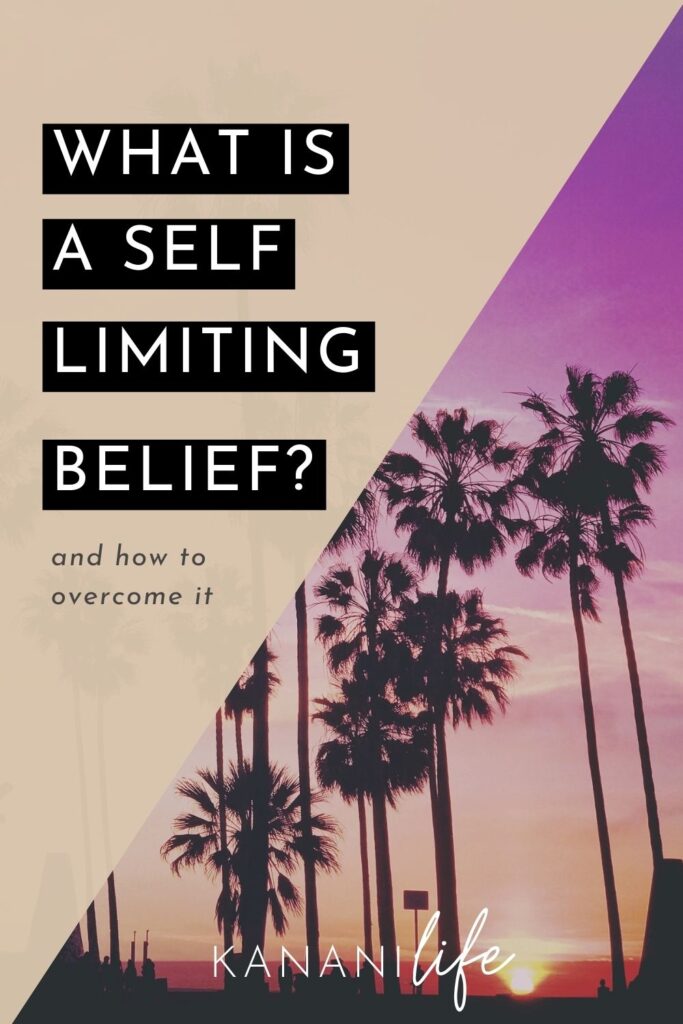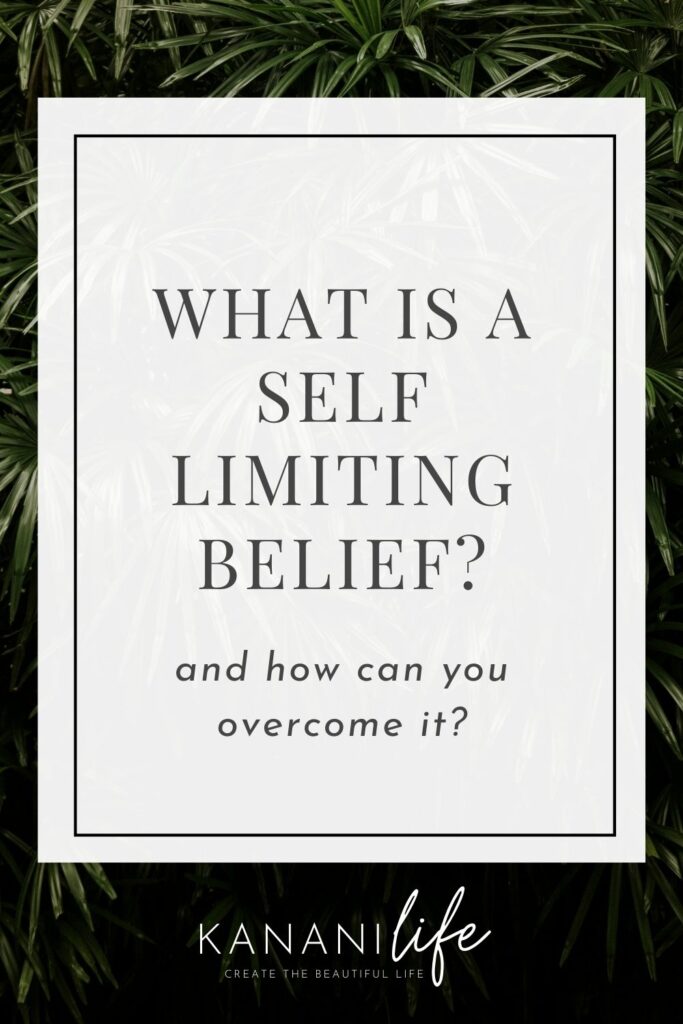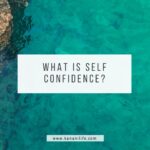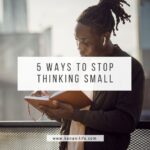
A self limiting belief is anything that causes you to believe you aren’t worthy or good enough. It causes you to doubt yourself, your skills, abilities, gifts, and purpose. Instead of feeling good about yourself, you feel like something is holding you back.
Spoiler alert: that something holding you back is the self limiting belief.
It’s hard to have a self limiting belief, because even if you do reach a goal, dream, or some accomplishment, you can feel like it wasn’t completely earned or that, somehow, you were held back. With self limiting beliefs, you can also have great circumstances yet feel like you’re somehow behind, missing out, or that there’s not enough.
In this article we’ll explore what is a self limiting belief and how you can overcome it.

What is a self limiting belief?
A self limiting belief is anything that hinders you from doing, performing, or feeling your best. It makes you feel unworthy and like anything you do is not enough.
Why do we have self limiting beliefs?
Sometimes self limiting beliefs are caused by trauma, tragedy, grief, or pain. Big experiences like these can change our perspective on life and ourselves. Often we compact our negative emotions and experiences into self limiting beliefs. Then we store the beliefs deep within us as a means of protection. Our conscious carries out these beliefs without us even realizing it… unless we stop and identify them, like we’ll do in this article.
Another huge contributor of self limiting beliefs is fear. We fear what we don’t understand or can’t control, and, often, subconsciously create beliefs about ourselves, people, or situations.
Especially when we’re children, we soak in the fears and beliefs from our experiences and the people around us. Our parents influence us in many ways and we gained a lot of our beliefs and outlook from the way they viewed finances, relationships, spirituality, work, and more. As children, we created our own beliefs and subconsciously found evidence to support them.

What is an example of a self limiting belief?
There are so many examples that it would take up volumes of books! But the main thing to know is that every person is unique, and while some people may share the same self limiting belief, the way they formed that belief may look completely different from someone else.
For example, a person who has been abused may form the belief that “I’ll always be abused by people” or they might form the belief that “I can’t trust anyone, no matter what.”
Other beliefs are based on life experiences like, “I’ll never be able to afford what I want” or “There’s not enough for everyone so I have to take as much as I can now.”
Sometimes we form beliefs purely on observations. Examples: “Relationships are hard.” “All people are selfish.” “I can’t be happy unless I have ___ (fill in the blank).”
All of these self limiting beliefs hinder us from progressing and feeling happy in the moment. They can often prevent us from reaching our goals too. With self limiting beliefs, it’s hard to feel content or satisfied with things like finances, dreams, your physical body, mental health, and so forth.

How can I overcome a self limiting belief?
Your confidence will grow as you recognize and work to overcome self limiting beliefs. There are several ways to overcome a self limiting belief but I’ve found it easiest to break the process into three simple steps.
I am not a licensed therapist or have studied psychology. This is purely based on my own experience and the experiences of others, but these steps have worked really well.
The three steps are 1) recognize, 2) find the source, and 3) create. Let’s dive into it.
Step 1 to overcome a self limiting belief: Recognize
To overcome your self limiting belief, you must first recognize what it is.
Listen to your thoughts, negative and positive.
Pay attention to the times you feel awkward, insecure, or lonely.
What caused those emotions?
The easiest way to recognize is to first feel the emotions and the words that describe those emotions. What are you feeling? Angry, sad, lonely, overwhelmed, disgusted, shy, or something else? Then, form a sentence around these words…
For example, if you feel angry when someone says or does something specific, ask yourself what’s going on in your head. Then, put the emotions into a sentence.
“I feel angry when people make assumptions about my life.”
Or here’s another example based on the feeling of sadness: “I feel really sad after feeling really happy.”
Another example is, “I always get anxious when relationships seem to go well.”
Here’s another example: “I am a broken person, and there’s no hope for healing.”
Do you get the idea? Self limiting beliefs can be pretty much anything.
Often you’ll find patterns and themes in your limiting beliefs. Sometimes limiting beliefs center around an emotion, circumstance, personality type, or something else.

Look for Themes
Look for themes in the beliefs you’re discovering.
For example, you might struggle with relationships, finding beliefs like “I can’t trust anyone” or “I can’t get too close to people” or “Relationships will always fail.” You can realize that these beliefs have a theme around relationships and distrust.
A common theme is feeling broken. A lot of people have gone through trauma and believe they’ll never feel complete, well, happy, or “normal” again. “I have too many problems” or “People won’t like me because of all I’ve gone through” or “I can’t relate with other people.” These all center around the general theme of brokenness.
It’s helpful to find themes because in the next step those themes will come in handy.
I’ve compiled a list of some themes and emotions that form the self limiting beliefs. Use this list to help get you started in identifying your limiting beliefs. When looking through this list, you might feel negatively about some, and positively about others. Take note of each feeling it ignites in you.
The words in the list below that resonate positively are telling you that you have healthy, truthful beliefs about them. Whereas the words that resonate negatively tell you that something might be off. Be sure to take note of the words that feel “off” or negative and ask yourself if you have a negative belief about it.
It’s easiest to do these exercises when you have some quiet time to yourself.
Themes:
- Abandonment
- Abuse
- Awkward
- Balance
- Betrayed
- Broken
- Change
- Confidence
- Deceived
- Deserving
- Education
- Enough
- Failure
- Family
- Fear
- Finances
- Helpless
- Hopeless
- Lonely
- “I will always feel______”
- Negative
- Neglect
- Overwhelmed
- Passion
- Relationship
- Safety
- Scarcity
- Stuck
- Talent
- Time
- Trust
- Unfulfilled
- Unworthy
- Weak

Step 2 to overcome a self limiting belief: Find the Source
Now that you have a list of beliefs and themes, it’s time to find the source of the beliefs. Our subconscious mind creates beliefs to protect us. A lot of us have experienced trauma, difficult circumstances, or anything else that has caused us to see the world and life in a false or negative perspective.
Don’t blame yourself for this. Usually we don’t even know we’re forming false beliefs because we’re simply processing through our experiences with the knowledge, experience, and maturity of season of life we were at.
For example, if you have relationship and trust issues, you might look back to the source and realize it stemmed from a childhood of people pleasing. Maybe your parents neglected you, so you did everything you could to please them. But because of your continued rejected efforts, you stopped trusting people.
Another example is that maybe you really wanted something (at any age) but you didn’t have enough money to buy it. As you continued to have plenty of wants, and not getting what you wanted, you formed the belief that you can’t afford anything.
A personal experience to illustrate the point
From personal experience, I had the belief that every time I felt happy, I’d feel sad afterwards. In other words “happiness is fleeting.” Deep in my heart I knew it wasn’t true, but I forced it to be true for myself. Self limiting beliefs can become self fulfilling prophecies. So after highs in my life, I hit very low lows. I braced myself mentally anytime I felt genuinely happy, because I knew soon after, there’d be a tidal wave of depression and sadness.
This stemmed from a childhood and life of disappointment, especially after big accomplishments. It seemed that nobody was really proud of me for the things I did—the achievements I received in high school, college, and so forth. I had to work through this belief and remind myself that not everything is perfect, and I can be happy where I am. I can validate myself and feel that God is pleased with me, instead of seeking happiness and validation from others.
That belief sometimes pops it’s head up here and there, but I consciously make an effort to disbelieve it and accept life as it happens.
So take the time to go back, sift through your experiences, memories, childhood, and life journey.
When were moments you felt the false belief? Can you let them go?
Forgiveness is a gift… for us. Can you forgive those who caused harm or pain to you? Will you accept what happened, learn from it, and give yourself permission to move forward?
Side note
A lot of overcoming false beliefs has to do with healing the inner child. That’s an article for another time, but just for the sake of this exercise, imagine your younger self. Now that you are where you are, what would you say to yourself then? How would you treat yourself? Take this time to heal the inner child in you. Nurture it. Let it know that everything is going to be ok. You made it this far, and it’s time to let go and heal.

Step 3 to overcome a self limiting belief: Create new empowering beliefs and consciously live them
Now that you’ve recognized your self limiting belief, found the source, and accepted/let go/forgave the experiences, people, or events that caused them, it’s time for the last step.
Create new empowering beliefs and live by them.
Creation gives us a zest for life, as well as self confidence to move forward no matter what happens. Be honest with your new, healthy beliefs to replace the old, self limiting ones.
For example, if you believed that all relationships fail, how can you change that to something positive? What will you change about this belief so it can be a healthy perspective on life and relationships?
From my personal experience I shared in the previous section, I had the belief that “I’ll always feel sad after something good happens.” My new belief went like this: “I can choose to be happy no matter the circumstances. Sometimes bad things will happen, but I won’t let that stop me from being happy or enjoying myself and my life.”
Your new, healthy belief doesn’t need to be as long as mine. Do whatever feels best and healthiest for you.
Create an affirmation that inspires and motivates you.
And, of course, live by your new belief. You might slip into old habits and self limiting beliefs, but try to stay present, mindful, and conscious of your thoughts.
In conclusion
You totally got this. Every person has self limiting beliefs, but when you work to overcome it, your confidence, wellbeing, and satisfaction with life increase. You feel more fulfilled, and are honest with yourself.
Instead of living by old scripts and old hurts, life has more freedom.
You got this friend!
Let’s hear from you!
What self limiting beliefs have you overcome? Let us know in the comments. We’d love to hear from you. Mahalo!
Save this pin for later!







